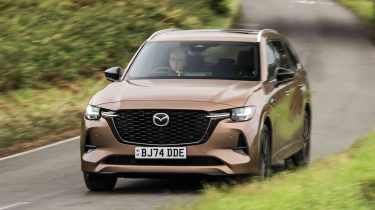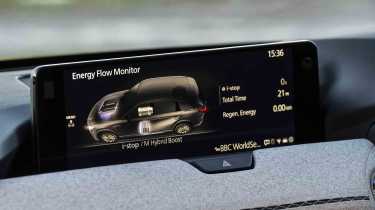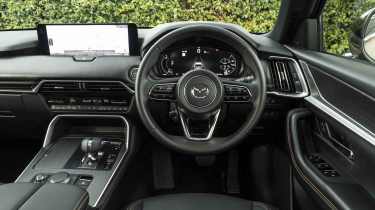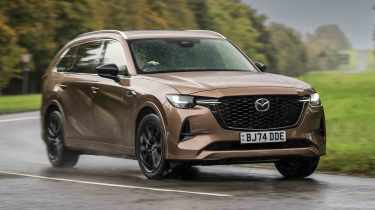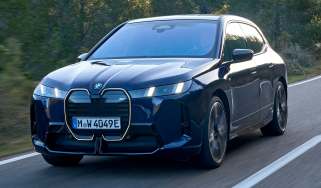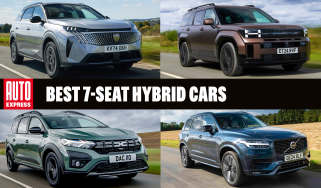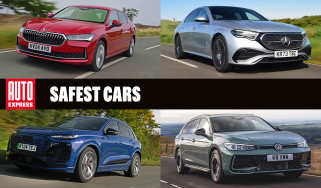Mazda CX-80 review
Mazda’s seven-seat SUV makes for an appealing and practical family car, with efficient powertrains and excellent build quality

Is the Mazda CX-80 a good car?
The Mazda CX-80 hits the right notes for a large SUV when it comes to rear seat space in the second and third rows. Its interior offers all the versatility you’d expect, and regardless of whether you go for the plug-in hybrid or six-cylinder diesel, the CX-80 is efficient. And despite the firm’s ambitions to push the car into premium territory, the pricing isn’t too aggressive. If the numbers add up, there’s plenty to like for buyers interested in a bigger family car.
If you’re looking for a seven-seat SUV, there’s no shortage of options. The challenge is how to stand out; while many try to achieve this, they often don’t quite hit the mark. Mazda, on the other hand, is pretty adept at going its own way, and it’s done so again with its first seven-seat SUV for the UK.
| Key specs | |
| Fuel type | Petrol plug-in hybrid, diesel |
| Body style | Six/seven-seater SUV |
| Powertrain(s) | 2.5-litre 4cyl petrol plus 1x e-motor, 17.8kWh battery pack, four-wheel drive 3.3-litre, 6cyl turbo diesel, four-wheel drive |
| Safety | 5-star (Euro NCAP, 2024) |
| Warranty | 3yrs/unlimited miles |
How much does the Mazda CX-80 cost?
Pricing for the Mazda CX-80 starts from just under £50,000 for the entry-level Exclusive-Line trim with the 2.5 plug-in hybrid power unit. The sportier-looking Homura comes in at nearly £53,000 (or around £55,500 for the Plus version), while the high-end Takumi starts at around £54,000 (or about £56,500 in Plus form). Those wishing to go for the 3.3-litre diesel will need to budget an extra £2,500 to £2,800 for the privilege, depending upon the trim level.
Speaking of trim levels, Exclusive-Line may be the entry-level trim, but it comes with plenty of attractive features, including leather seats, tri-zone automatic climate control, LED headlights and 18-inch alloy wheels. Above this is the Homura, which has a sportier look and feel thanks to darkened trim, black 20-inch wheels, and an array of extra equipment. The top-spec Takumi, has a more obvious ‘luxury car’ bent, thanks to a light-coloured interior and additional chrome highlights.
Both the Homura and Takumi can be upgraded with a Plus Pack, which adds high-end features including a panoramic sunroof, adaptive headlights and a privacy glass tint on the rear windows.
The 3.3-litre in-line six-cylinder diesel option might be worthwhile for those who regularly tow a caravan or trailer, but it is the plug-in that’s expected to account for the majority of UK sales.
Engines, performance & drive
A major part of why the Mazda CX-80 is different from most of its competitors is due to its engine range – specifically the diesel. Like premium brands BMW and Mercedes, the CX-80 uses a comparatively large 3.3-litre straight-six mounted longitudinally, or lengthways, rather than the more traditional transversely mounted four-cylinders found in its mainstream challengers these days. The market has gone to smaller engines due to ever-tightening emissions regulations and the drive for lower fuel consumption.
In order to comply with the demand for increasing efficiency, this engine is aided by a 48-volt mild-hybrid system, or ‘M-Hybrid Boost’ as Mazda calls it, in which a small 17bhp electric motor assists the engine when pulling away from a standstill and at low revs to boost efficiency. With 251bhp and 550Nm of torque on tap, 0-62mph takes 8.4 seconds. This translates to some fairly good on-road performance, and there are no noticeable gaps in the torque delivery, which helps the diesel CX-80 avoid feeling strained or rushed.
The benefit is an extra layer of sophistication to the drive, which is more reminiscent of a BMW X5 than anything with a Mazda badge. The engine isn’t quite as silky-smooth as in premium German rivals, nor is the eight-speed automatic transmission as slick or well-calibrated. But this is a fine powertrain, especially considering the price point.
The plug-in hybrid Mazda CX-80 takes a slightly more standard approach in swapping the in-line six for a 2.5-litre four-cylinder petrol engine, but here it works together with a much more powerful 173bhp electric motor that’s fed by a 17.8kWh lithium-ion battery.
The total power output for the CX-80 PHEV is 323bhp, and there’s 500Nm of torque, with the e-motor providing a big chunk of that instantaneously. This allows the two-tonne SUV to dispatch 0-62mph in 6.8 seconds.
While the performance of this model is slightly more electrifying – no pun intended – with a more pronounced turn of speed, the way the plug-in hybrid transitions between petrol and electric drive isn’t quite as well resolved as is the case with some rivals. There’s also a touch of electric motor whine, and the car can get a little jerky if you ask for lots of power in its standard drive mode.
Sport mode does a good job of smoothing things out, as this relies on the petrol engine, with the electric motor purely being a source of additional power and torque, rather than driving the wheels independently.
The CX-80 uses double-wishbone front suspension and a multi-link set-up on the rear that Mazda says has been tuned for stability and comfort. It also gets Kinematic Posture Control (KPC) technology from the Mazda MX-5 sports car that is supposed to reduce body movement during cornering.
This SUV also uses a four-wheel drive system that is biased toward sending most of the engine’s power to the rear wheels, which should benefit the handling balance further, but it’s not an unqualified success here. The CX-80 feels like a Mazda thanks to its accurate steering and general poise, but it’s also to the detriment of the ride, which is unsettled, even on smooth roads.
Small bumps at low speeds can often catch the CX-80 out, resonating through the cabin despite the relatively modest 20-inch wheel size. The flip side of this is that the handling is sensible rather than spectacular, and we’re not sure it’s a worthy trade-off for the sake of the ride – especially when most people buy an SUV for comfort reasons, rather than because it’s supposed to handle like a sports car.
| Model | Power | 0-62mph | Top speed |
| Mazda CX-80 PHEV | 323bhp | 6.8 seconds | 122mph |
| Mazda CX-80 Skyactiv-D | 251bhp | 8.4 seconds | 135mph |
MPG, emissions & running costs
| Model | MPG | C02 | Insurance group |
| Mazda CX-80 PHEV | 176.5mpg | 36g/km | 37-39 |
| Mazda CX-80 Skyactiv-D | 48.7-49.5mpg | 148-151g/km | 37-39 |
To make its latest diesel engine as clean and efficient as possible, Mazda developed a clever new technology called DCPCI (Distribution-Controlled Partially Premixed Compression Ignition), which uses a unique egg-shaped combustion chamber to deliver cleaner fuel combustion. It also added a 48-volt mild-hybrid system, and as a result, the brand says the diesel CX-80 can return up to 49.5mpg.
Meanwhile, the CX-80 PHEV can officially return up to 176.5mpg, and has a pure-electric range of 37 miles from a single charge of its 17.8kWh battery. Fully recharging the battery using a typical 7kW home wallbox should take about two and a half hours. However, the CX-80 PHEV doesn’t have any DC rapid charging capabilities for a quick top-up on longer trips, unlike the Skoda Kodiaq.
At least it does feature an EV mode for running as long as possible with the engine off, plus a ‘Charge’ mode that ensures the battery maintains a certain amount of charge for use later in a journey – such as driving to your destination in a low-emissions zone inside a city.
Company car drivers paying Benefit-in-Kind (BiK) tax will be better off with the plug-in hybrid version thanks to it being in the lower 12 per cent BiK band (rising to 13 per cent for the 25/26 tax year) versus the diesel in the 34 per cent band (rising to 35 per cent for 25/26 tax year). Private buyers will be hurt by the fact that every version of the CX-80 breaches the £40,000 threshold for the luxury car tax, meaning you’ll need to pay a higher rate of annual tax from the second time the vehicle is taxed up until it is six years old.
Insurance isn’t inexpensive, but it will be on par with rivals like the Hyundai Santa Fe. The CX-80 in both diesel and plug-in hybrid forms starts in group 37, rising to group 39 for the higher trim levels. However, the Skoda Kodiaq is likely to be much more affordable, staring in group 18 for the mild-hybrid petrol, before rising to group 24 for the plug-in hybrid.
According to our expert data, the CX-80 is expected to retain 53-54 per cent of its original value over three years or 36,000 miles, depending on the trim and engine choice. That’s better than the Kodiaq, which is likely to hang on to 41-50 per cent over the same period. It’s also slightly better than the Santa Fe, which is predicted to maintain 45-48 per cent.
Design, interior & technology
The cabin in the Mazda CX-80 is generally well built, with appealing materials and a good combination of colour and trim options to suit different tastes. There’s not an excess of delicate, scratchable materials that might be at risk from smaller members of the family – both human and canine – but on the two upper trims, the seats and dash do feature some nice, supple leather.
High-spec Takumi models feature a bright and airy white leather finish, with blonde timber inserts, high-gloss metal-look trim and textured fabrics, but if this all feels a little delicate for a family hauler, the Homura’s black Nappa leather seems just as premium. Its overall design isn’t exactly cutting-edge and potentially lacks the coolness exuded by rivals such as the Hyundai Santa Fe, but there’s nothing wrong with the quality or construction.
Sat-nav, stereo and infotainment
Every CX-80 is equipped with a 12.3-inch digital instrument cluster and a 12.3-inch central display. It’s worth noting, though, that the latter is not a touchscreen, because Mazda prefers having a rotary dial on the centre console to navigate its infotainment menus. Amazon’s virtual assistant Alexa comes built-in, though, and can control the car’s music, navigation and air-conditioning, as well as third-party apps such as Spotify. Wireless Apple CarPlay and Android Auto are standard-fit, too.
Boot space, comfort & practicality
| Dimensions | |
| Length | 4,995mm |
| Width | 1,890mm |
| Height | 1,710mm |
| Number of seats | Six or seven |
| Boot space | 258/687/1,971 litres (7,5,2 seats up) |
The CX-80 comes with seven seats as standard, but two six-seater layouts are also available. These replace the second-row bench with two captain’s chairs, with the option to have an open walk-through space between them, or a console with extra storage and cup-holders.
There’s plenty of room in the second row, plus a separate set of climate controls for passengers and some USB-C charging ports for their devices. Huge rear doors create a large opening, allowing for easier access to the third row of seats, although you won’t be able to open those doors fully when squeezed into a tight parking space.
Unlike some seven-seat SUVs, there’s more than enough headroom and legroom in the rearmost seats for even six-feet tall adults to get comfortable. We noticed that the third-row seats are shallow, which meant our legs were slightly raised from the seat bases, but it’s a minor gripe. It is impressive that Mazda has been able to keep the seven seats in plug-in hybrid versions, which is more than can be said of the Skoda Kodiaq.
A separate set of air vents and cup-holders are handy touches for those in the back. There’s 258 litres of boot capacity available with all the CX-80’s seats in place, and that grows to 687 litres when the rearmost seats are folded flat – a process which is quick and simple to do by pulling straps on the backs of both. When all but the driver and front passenger seats are down, the CX-80 can carry up to 1,221 litres of cargo, or 1,971 litres if you load it right to the ceiling.
Mazda is keen to highlight the CX-80’s 2,500kg maximum towing capacity, which applies to both diesel and plug-in hybrid models. The car also features a ‘Trailer Hitch View’ for its camera system, to make it easy for the driver to attach a trailer when they’re on their own, while a dedicated Towing drive mode takes into account the additional weight of a trailer and optimises the AWD system to improve straight-line stability.
Safety & reliability
Safety experts Euro NCAP awarded the Mazda CX-80 the maximum five-star rating after crash testing it in 2024. The CX-80 scored higher than the Hyundai Santa Fe and Skoda Kodiaq in the adult occupant and vulnerable road user categories, and matched the Santa Fe in the child occupant and safety assistance technology categories.
Mazda is introducing the latest suite of safety features with the CX-80, such as head-on collision mitigation as part of an upgraded Smart Brake Support system, and ‘Cruising and Traffic Support, which can take action if the driver becomes unresponsive. Other safety kit fitted as standard includes blind spot monitoring, cruise control, lane keep assist, traffic sign recognition and driver attention alert.
A 360-degree camera is offered on the CX-80 and features the aforementioned ‘Trailer Hitch View’ and a ‘See-Through View’ to help when manoeuvring in tight car parks and city streets.
The Mazda brand came in an excellent seventh place out of 32 manufacturers in the 2024 Driver Power customer satisfaction survey, higher than Hyundai (17th place) and Skoda (23rd place). Owners praised the user-friendly controls and the infotainment system, with the few negatives mentioned surrounding acceleration and visibility.
Servicing for the CX-80 is required every 12 months or 12,500 miles, and you can spread the cost of maintenance by purchasing a three-year or 37,500-mile service plan with your car. Pricing for the CX-80 has yet to be announced, but we expect the costs to be similar to the smaller Mazda CX-60 because both use the same diesel and plug-in hybrid powertrains.
| Key standard safety features | Euro NCAP safety ratings |
|
|
Mazda CX-80 alternatives
The Mazda CX-80 joins a class that includes the very fresh-looking Hyundai Santa Fe, the Kia Sorento, plus slightly smaller seven-seat rivals such as the Peugeot 5008, Nissan X-Trail, and Skoda Kodiaq.
Arguably the CX-80’s key rivals are seven-seat SUVs from Korean stablemates Hyundai and Kia. The Hyundai Santa Fe is one of the best choices in this area of the market with its boxy design and a set of hybrid and plug-in hybrid powertrains. It actually has a similar set of compromises to the Mazda, though, with a hesitant hybrid powertrain and iffy ride quality on rough roads. Plus it also doesn’t have a diesel option.
Kia’s Sorento is similar under the skin to the Santa Fe, but is a slightly older design and lacks the Hyundai’s visual punch. It does ride better, and there’s a diesel in the range for those who like to tow or regularly drive long distances. However, the diesel in the Sorento is only a four-cylinder, so it lacks the Mazda’s six-cylinder sophistication and refinement under load. Both the Kia and Hyundai are comparable in terms of dimensions and interior accommodation.
Smaller rivals from Japan and Europe include the Nissan X-Trail and Skoda Kodiaq. Both are cheaper, but because of their size, the third row is more for occasional use, rather than full-time deployment. The Kodiaq, particularly, comes with a strong range of powertrains, with diesel, petrol and plug-in options (although you lose the seven-seat option with the latter), and is highly rated thanks to its clever design, excellent tech and relative efficiency – although pure-petrol models do have a habit of drinking lots of fuel.
Frequently Asked Questions
On test, we averaged around 46mpg, which isn’t far off the claimed figures. This was across a combination of slow-speed town driving and A-roads, plus some time on the high-paced autobahn. The plug-in hybrid will always have a more variable figure depending on how often you charge the battery pack, but we recorded a 68mpg figure after a stint on the high-speed autobahn and crawling in urban traffic. Consumption will go up if the battery depletes, but as the petrol engine is not turbocharged, the efficiency shouldn’t drop to quite the same extent as with some rivals.


